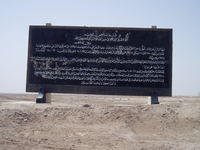Thursday, August 04, 2005
Between Basra and Fao
 The countryside between Basra and Fao is flat, dry, parched except for some sickly-looking salt flats, and almost completely destitute of vegetation. Tattered black flags--Shia flags--fly from sticks jammed into small hills out in the desert, on the horizon, an enormous oil refinery smokes and burns and shimmers in the heat. With Layla translating, Abbas tells us how, a quarter-century ago, this expanse of dessicated earth once flowered with palms, trees, flowers, wildlife of all description--a verdant garden of date groves and streams and blessed shade. But the Iran-Iraq War destroyed it all, Abbas continued--bombs, rockets, machine gun fire cutting down and churning up the groves like a gigantic scythe and plow.
The countryside between Basra and Fao is flat, dry, parched except for some sickly-looking salt flats, and almost completely destitute of vegetation. Tattered black flags--Shia flags--fly from sticks jammed into small hills out in the desert, on the horizon, an enormous oil refinery smokes and burns and shimmers in the heat. With Layla translating, Abbas tells us how, a quarter-century ago, this expanse of dessicated earth once flowered with palms, trees, flowers, wildlife of all description--a verdant garden of date groves and streams and blessed shade. But the Iran-Iraq War destroyed it all, Abbas continued--bombs, rockets, machine gun fire cutting down and churning up the groves like a gigantic scythe and plow.
We flash by berms and small hillocks with sloping sides--tank defenses and artillery emplacements. Twisted, rusting metal fragments of oil installations obliterated in the Iranian fighting. Charred and blackened stumps jutting up by the roadside--the last remains of nakhil, or date palms. A large mural rising up from the desert floor, Arabic words carved in a large slab of black stone. Abbas slows the car as Layla translates. "Fifty-two thousand Iraqi men killed in the battle of Fao ... One hundred-twenty thousand Iranians ... over six million artillery shells falling in this area ..." She pauses. I glance back to see she is crying.
What this memorial only suggests--and what Layla remembers all-too-vividly--is the absolute horror of the war.
 The countryside between Basra and Fao is flat, dry, parched except for some sickly-looking salt flats, and almost completely destitute of vegetation. Tattered black flags--Shia flags--fly from sticks jammed into small hills out in the desert, on the horizon, an enormous oil refinery smokes and burns and shimmers in the heat. With Layla translating, Abbas tells us how, a quarter-century ago, this expanse of dessicated earth once flowered with palms, trees, flowers, wildlife of all description--a verdant garden of date groves and streams and blessed shade. But the Iran-Iraq War destroyed it all, Abbas continued--bombs, rockets, machine gun fire cutting down and churning up the groves like a gigantic scythe and plow.
The countryside between Basra and Fao is flat, dry, parched except for some sickly-looking salt flats, and almost completely destitute of vegetation. Tattered black flags--Shia flags--fly from sticks jammed into small hills out in the desert, on the horizon, an enormous oil refinery smokes and burns and shimmers in the heat. With Layla translating, Abbas tells us how, a quarter-century ago, this expanse of dessicated earth once flowered with palms, trees, flowers, wildlife of all description--a verdant garden of date groves and streams and blessed shade. But the Iran-Iraq War destroyed it all, Abbas continued--bombs, rockets, machine gun fire cutting down and churning up the groves like a gigantic scythe and plow.We flash by berms and small hillocks with sloping sides--tank defenses and artillery emplacements. Twisted, rusting metal fragments of oil installations obliterated in the Iranian fighting. Charred and blackened stumps jutting up by the roadside--the last remains of nakhil, or date palms. A large mural rising up from the desert floor, Arabic words carved in a large slab of black stone. Abbas slows the car as Layla translates. "Fifty-two thousand Iraqi men killed in the battle of Fao ... One hundred-twenty thousand Iranians ... over six million artillery shells falling in this area ..." She pauses. I glance back to see she is crying.
What this memorial only suggests--and what Layla remembers all-too-vividly--is the absolute horror of the war.

